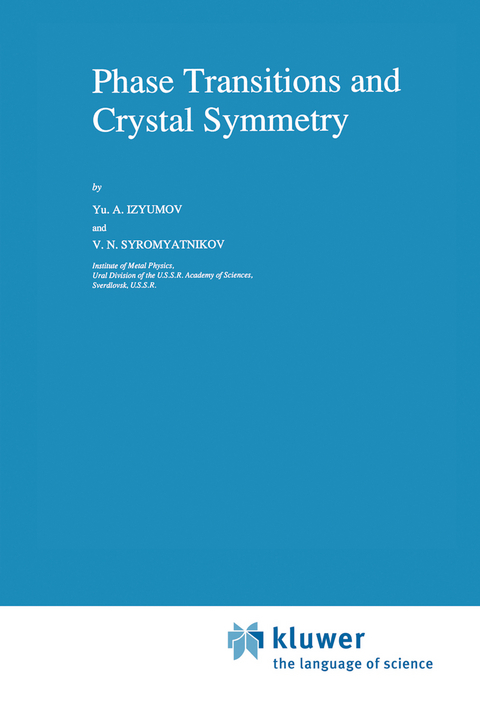
Phase Transitions and Crystal Symmetry
Springer (Verlag)
978-94-010-7357-8 (ISBN)
1. Introduction to Phenomenological Phase Transition Theory.- 1. Fundamentals of Landau’s Thermodynamic Theory.- 2. Prerequisites on Space-group Representations.- References.- 2. Physical Realization of the Order Parameters at a Microscopic Level of Description.- 3. Tensor Representation of the Space Group on a Basis of Localized Atomic Functions.- 4. Permutational Representation and its Basis.- 5. Vector Representation and its Basis.- 6. Pseudovector Representation and its Basis.- References.- 3. Symmetry Change at Phase Transitions.- 7. Change in Translational Symmetry.- 8. The Total Symmetry Change.- 9. Domains.- 10. The Paraphase.- References.- 4. Analysis of the Thermodynamic Potential.- Invariant Expressions of the Thermodynamic Potential.- 12. Integral Rational Basis of Invariants.- 13. Examples of the Construction of an IRBI.- 14. Irreducible Representation Images and Thermodynamic Potential Types.- 14. Irreducible Representation Images and Thermodynamic Potential Types.- 5. Phase Diagrams in the Space of Thermodynamic Potential Parameters.- 15. Theoretical Fundamentals of the Phase Diagram Construction Method.- 16. The One-Component Order Parameter.- 17. The Two-Component Order Parameter.- 19. The Role of the IRBI in the Construction of Phase Diagrams.- 20. Coupling Order Parameters.- References.- 6. Macroscopic Order Parameters.- 21. Transformation Properties of the Order Parameters.- 22. Interplay of Micro- and Macroparameters.- 23. Ferroics.- 24. Non-ferroics.- References.- 7. Phase Transitions in an External Field.- 25. Phase Diagrams.- Features Peculiar to the Temperature Behavior of Susceptibility in the Vicinity of the Second-Order Phase Transition.- Calculation of Susceptibilities for Second-Order Phase Transitions.- Singularities of theSusceptibility in the Vicinity of the First-Order Phase Transition.- 29. Domains in an External Field.- References.- 8. Martensite Transformations.- 30. Reconstructive Structural Transitions.- 31. Thermodynamic Analysis of the Homogeneous State.- 32. Inhomogeneous States in the Vicinity of the Phase Transition.- 33. The Omega Phase.- References.- 9. Incommensurate Periodicity Phases.- 34. General Approach to the Problem.- 35. Phases without Linear Gradient Terms in Free Energy.- 36. Phases with Linear Gradient Terms.- 37. Multi-?-structures.- 38. Incommensurate Phases in External Fields.- 39. The Thermodynamics of Phase Transitions to Incommensurate Phases.- References.- 10. Color Symmetry and its Role in Phase Transition Theory.- 40. Color Symmetry in the Theory of Magnetic Structures.- 41. Supersymmetry of Incommensurate Structures.- 42. Icosahedral Symmetry of Crystals. Quasicrystals.- 43. Color Groups in the Theory of Systems with a Quantum Mechanical Order Parameter.- References.- 11. Fluctuations and Symmetry.- 44. Fundamentals of the Fluctuation Phase Transitions Theory.- 45. Critical Behavior of Anisotropic Systems.- 46. Fluctuation-Induced Break-Down to First-Order Phase Transitions.- 47. Fluctuations in the Vicinity of Multicritical Points.- References.
| Reihe/Serie | Fundamental Theories of Physics ; 38 |
|---|---|
| Zusatzinfo | XX, 444 p. |
| Verlagsort | Dordrecht |
| Sprache | englisch |
| Maße | 155 x 235 mm |
| Themenwelt | Mathematik / Informatik ► Informatik ► Theorie / Studium |
| Naturwissenschaften ► Geowissenschaften ► Mineralogie / Paläontologie | |
| Naturwissenschaften ► Physik / Astronomie ► Atom- / Kern- / Molekularphysik | |
| Naturwissenschaften ► Physik / Astronomie ► Festkörperphysik | |
| Naturwissenschaften ► Physik / Astronomie ► Mechanik | |
| Naturwissenschaften ► Physik / Astronomie ► Thermodynamik | |
| Technik ► Maschinenbau | |
| ISBN-10 | 94-010-7357-0 / 9401073570 |
| ISBN-13 | 978-94-010-7357-8 / 9789401073578 |
| Zustand | Neuware |
| Informationen gemäß Produktsicherheitsverordnung (GPSR) | |
| Haben Sie eine Frage zum Produkt? |
aus dem Bereich


